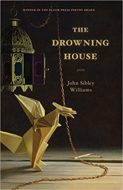 John Sibley Williams
John Sibley Williams
The Drowning House
Elixir Press
Reviewer: Vivian Wagner
John Sibley Williams’ new collection of poetry, The Drowning House, is a book about personal, cultural, and generational trauma. It explores American violence, racism, and colonialism, telling multiple stories from a variety of perspectives about the intersecting traumas inflicted by this country’s people, as well as the myths that have given rise to and sustained those acts of violence. The collection also navigates a minefield of culpability, responsibility, and potential atonement, acknowledging that there are no easy answers to or escape from all the damage that’s been and continues to be done.
The first piece in the collection is a prose poem entitled “In the Beginning the Bodies were Too Soft,” which serves as a kind of prologue and sets up one of the book’s major themes, the simultaneous vulnerability of the human body and resiliency of the human spirit. It also explores the relationship between traumatized bodies and the landscape, history, and culture in which they find themselves: “Earth still spits, I’m told by the people stripped of all but a few arid acres, gifted as a sort of apology, amends. They tell me the land is still too hard or too soft & the bodies that can’t enter it.”
Referencing the treatment of indigenous and enslaved peoples as one of the original sins of this country, this poem looks askance at the narratives that have at once done irreparable harm and sought, unsuccessfully, to cover over that harm.
The remaining poems in the book are organized into three sections, entitled “My American Ghost,” “No Good Night,” and “Summon.” Ghosts are another central theme of the book, ghosts that speak about and reenact lynchings, hangings, lootings, family separations, and all manner of individual, cultural, and political violence. Sometimes these ghosts speak directly, sometimes they’re referred to obliquely in the imagery and stories of the poems in which they appear.
The first poem in the “My American Ghost” section is called “Pantomime,” and it describes a simple, domestic image—sheets—which carry, as well, the weight of racism:
Outside sheets are pulling
back together into bodies.
The wind confuses sway
with dance, asks the dresses
there’s no one left to wear
for one more go before
the music ends.
This poem suggests that the cultural artifacts that surround us, such as sheets and dresses swaying in the wind, have multiple meanings. They’re not innocent. They start to take the form of bodies, of ghosts, of the past and the future. The speaker identifies other everyday images and finds their significance confusing and blurry, even as he starts to see the ways in which they embody lives, bodies, violence, and history:
Deer that might be
mothers or sisters, gutshot,
looking for a slice of shadow
to die in. So many hanging trees
we confuse with men.
Deer, who might also be “mothers or sisters,” are looking for shadows to die in, and trees are not just trees, but “hanging trees.” This double-vision is common to the poems in this collection; nothing is simply one thing. Everything is made up of layers of history, culture, and meaning. With the poet’s close attention to detail and nuance, underlying layers are revealed and become visible.
Another poem in this section, “The Dead Just Need to Be Seen, Not Forgiven,” looks at one particularly terrifying ghost in the speaker’s own family:
That old man in the photo our family never talks about,
known best for tracking runaway slaves; tonight
we drag him from the basement up these loose
wood stairs & set out a plate of salted cabbage & rabbit—
so long since I’ve asked why the empty chair at our table.
Dragging up the ghost of this white man who tracked runaway slaves means speaking about something the speaker’s family “never talks about”—an open secret, an “empty chair.” The speaker wants to tell this story, but struggles to find a way to tell it truthfully, locating himself at the nexus of recognition, guilt, and responsibility.
The names we call each other
linger luminous & savage. Still. That tree I used to hang
tires from holds tight its dead centuries.
The poem looks through the murk of myth and silence in order to see what happened, what’s happening, and what’s to be done now. This tree is not just a tree, and the speaker suggests that he, too, has done his share of hanging.
Ropes, trees, bodies: these images crop up throughout the poems in this collection, with a sense of horror underlying even the most seemingly innocent of images. These poems want readers to question whether there can ever be a true innocence, even in childhood, given the layers of history and unspoken, perhaps unspeakable, acts.
We hear, for instance, in “Regardless, There Will Be Bodies,” of bodies “dragged for miles behind rusty pick-ups filled with boys / daring the night to stop them”—in reference to the horrific 1998 murder of James Byrd, Jr. in Texas. Terror and cruelty are around every turn, with the poems exploring a history and culture of violence and racism. Each act layers upon another, and another. The poems excavate these layers of history, and in so doing attempt to demonstrate their inevitable impact on the present.
The poems also explore responsibility and guilt, looking at the way in which people commit and justify violence. In “Americanisms,” for example, the speaker explores the perspective of white working-class people and the skewed reasoning behind their rage:
How ever since the factory fell
Into smokeless silence, the men
have brought their rough & raging gods
home to tend to like another man’s child.
Everyone in the town is “walking bitterly on their mouths,” we hear, and the terror of impending violence is palpable:
The bars are all 24-7 now. How
when we say the thing that’s wrong with
this country, the forgive me is implied.
This poem glimpses the sense of responsibility that even the most violent can have, and also the way those same people can justify their violence and continue to enact it.
The collection’s second section, “No Good Night,” explores contemporary stories of American terror, including family separations at the border. In “Separations,” for instance, we hear of the trauma of physical and psychological partitions:
Silver wire partition bodies
from the bodies they birthed
six years ago in wire-thin
stucco houses open-walled
to dust & sky.
And in “Uncoordinated Efforts,” there’s a look at Puerto Rican people recovering from Hurricane Maria in 2018, beginning with a pun lifted from a news report: “Desperation set in”: Puerto Ricans grab shovels, machetes to help restore power.” Restoring power, of the electrical and political kind, is at the heart of the poem, which looks at the ways this was a story not just of a single storm but of the legacy of colonialism: Sometimes a palmful of water is enough / to keep an island from statehood, power.”
These are contemporary poems that refuse to let the reader rest in any kind of “good night”: there’s so much harm that’s been done, and so much to recover from, that the poems suggest the only response can be to tell and listen to these endlessly intersecting stories of devastation and abuse. Only through acknowledging these stories can we hope to move forward, and even then the path ahead is tenuous and uncertain, given the many ghosts of imperialism and brutality that can’t easily be erased.
The poems in the collection’s final section, “Summon,” explore the idea that maybe erasure of ghosts isn’t the answer, but rather an active, clear-eyed summoning of them. In “It’s Not Corpses We Burn on Pyres Anymore,” for instance, the speaker looks at the vital work of truth-telling and recognition:
In hindsight our heroes weren’t so much
the saving from kind. Conquistadors & secret
slave owners. Gunslingers. Lovers hard & wild
as the lands they tamed. Great-grandfathers.
Sometimes America breaks our hearts
& sometimes we’d kill for a chance
to do the breaking.
Understanding the frenetic brutality in the country’s present means seeing the great-grandfathers who gave rise to it in the past. Comprehending the ghosts in one’s own house, mind, and body is a start toward exorcizing them. Maybe then, and only then, is there any hope for healing and forgiveness, as hinted at in the collection’s final poem, “My Heart is in the Mouth of Another Heart”:
Among the burning crosses, churches, refineries at dusk, a bridge
that shouldn’t be there. May we say we see it through the smoke.
Like forgiveness. All this impossible forgiveness.
May the dead believe us when we say it.
This forgiveness hasn’t yet been earned, and might never be, but it can just barely be glimpsed through the smoky dust of denial, untruth, and myth. The poems in The Drowning House aim to speak the words that must first be spoken before any healing can begin.

